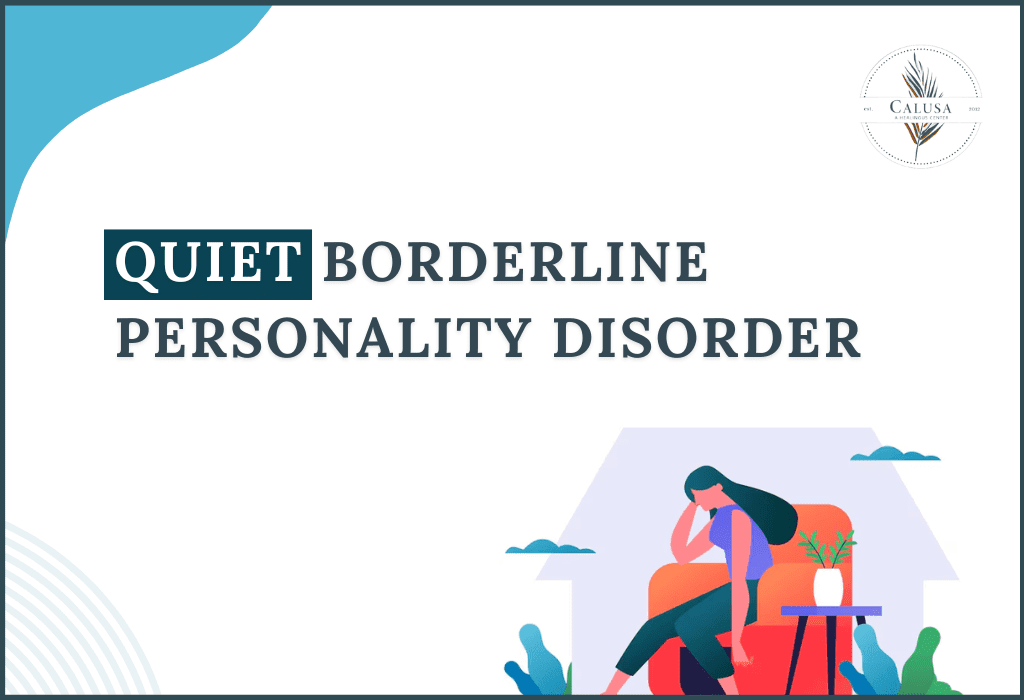Quiet Borderline Personality Disorder (BPD) is regarded as a subtype of Borderline Personality disorder in which the sufferer may undergo a number of intense emotions and mood swings or face inner conflict but direct all the turmoil within rather than to the outside. The inward type of BPD is often overshadowed and overlooked because it does not draw attention; people suffering from it do not attempt to act out their emotional state and simply internalize all the dramatic issues. This means that all their emotional pain, fear of abandonment, loss of identity, etc., things that are very painful for people, still exist but do so on the unconscious level, thus making it even more of a struggle for other people even to begin to understand what people go through.
Someone with Quiet Borderline personality disorder would outwardly appear calm even though inside, they are angry, sad, ashamed, and many more feelings all at once that cannot seem to be placed in order. This internalization can make Quiet BPD even more complex to identify and treat as the outward signs one can see in others with borderline are less because they tend to internalize issues. Even so, they face a similar amount of emotional turmoil that comes with the condition and instability as any other BPD syndrome.
Causes & Risk Factors of Quiet BPD
Ultimately, professional literature covers the explanation of Quiet Borderline Personality Disorder on the surface, other than mentioning the fact that the condition is complex and would involve more than one contributing factor. Below are some of the key causes and risk factors:
- Genetics: There may be a hereditary component affecting BPD.
- Childhood Trauma: Child abuse and neglect may be risk factors for BPD.
- Brain: Structural and functional brain differences may be factors.
- Personality: Risk factors may include vulnerability, overachievement, and negative inner dialogue.
- Environment: BPD symptoms may emerge in response to life stressors.
Triggers that Can Lead to an Episode of Quiet BPD
There are various situations that can trigger an episode of Quiet BPD. Identifying the existing letters is very important because the management of the disorder can become effective. A couple of revenant triggers include:
- Fear of Abandonment: Those who have this fear often can overlook even the smallest of events because it will turn into intense emotions.
- Interpersonal Conflict: After arguments, people are often left with strong emotional feelings.
- Stressful Situations: Activities that place individuals in difficult situations can be attractive and simultaneously reveal symptoms in the patient.
- Relationship Changes: Adapting to changes in relationships that are dear to them might be troublesome.
- Negative Self-Perception: Instead of improving themselves, the self-hate leads to self-destructive acts perceived as punishment.
Understanding and identifying these triggers can help individuals with Quiet BPD and their family members cope with the exacerbations of the disorder.
Signs and Symptoms of Quiet BPD
Signs and symptoms of Quiet Borderline Personality Disorder can be very soft, notably couched, and thus easy to misinterpret or miss altogether. Their impact does not differ from that of the external types of the disorder. Some of these symptoms are as follows:
- Internalized Anger: When an individual has problems with anger management and decides to overthrow the hatred towards oneself or self-burn.
- Emotional Numbness: Absence of any feelings or detachment from what is really happening.
- Chronic Emptiness: Excessive and compulsive feelings of emptiness and the development of an undefined self.
- Fear of Abandonment: There is a significant concern about abandonment even in relationships that are not abusive.
- Self-Blame: Blame one’s self for things that should not necessarily warrant self-blame.
- Social Withdrawal: Voluntary confinement in the house to avoid emotionally distressing situations.
- Perfectionism: Purposefully setting over-the-top and impossible expectations and thus facing dissatisfaction and failure.
- Difficulty Expressing Emotions: Difficulty in emotions or vocalizing their emotional state, resulting in coiling in the trauma.
How to Help Someone with Quiet BPD
Providing any support, particularly to people with Quiet BPD, can be daunting as the challenges that affect them are more often than not hidden. But here are the useful techniques that will provide the help they need:
- Offer a Nonjudgmental Listening Ear: Listen in an understanding tone or speak in a manner that does not reprimand an individual.
- Validate Their Feelings: Understand how bothered they get to a point where they run out of words and agree with them even if it sounds like the feeling is irrational.
- Encourage Professional Help: Quiet borderline disorder is adequately managed when therapy or counseling is pursued and treatment.
- Be Patient and Understanding: Healing depends on how guilty a person feels about seeking assistance. Sometimes, they may not wish to heal, and you have to understand that it becomes their choice.
- Help Them Identify Triggers: Work with them to find possible triggers and create ways to counter them.
- Avoid Criticism: Gentle BPD patients are typically quite alert to criticism, which may enhance their distress.
- Encourage Healthy Habits: Encourage them to undertake positive activities such as exercising, pursuing leisure activities, or practicing mindful stress relief techniques that will help them better deal with stress and emotional turmoil.
Getting Support for BPD
Lack of support is a main contributor to ineffectiveness in the management of Quiet Borderline Personality Disorder. There are many ways to support this:
- Therapy: Of all the available approaches to therapy, Dialectical Behavior Therapy (DBT) is noted to be the most efficient one for BPD. It seeks to teach patients how to control their feelings, eliminate self-harming acts, and relate better with other people.
- Support Groups: Su¢ering from psychological problems is at times almost unbearable in the absence of group members sharing the same burdens. Support groups, if not treatment, play a huge role in the recovery of these members.
- Family Therapy: Therapists use Family member’s engagement in their therapy, and the outcomes expect families to assist people in accomplishing better socially spanning Balanced Marital Family Societies
- Online Communities: There are many popular forums where Quiet BPD sufferers can interact and help each other.
Getting a Diagnosis
Unfortunately, there is very little hope of being able to treat Quiet Borderline Personality Disorder as its symptoms are dormant and hardly expressed to others. But coming up with a correct diagnosis is the first step to healing.
- Consult a Mental Health Professional: A psychologist or psychiatrist may perform a thorough assessment, such as interviewing and using history, symptoms, or questionnaires.
- Be Honest About Your Symptoms: If something is bothering you, it is important to let the psychologist know such an issue, even if the truth is rather unpleasant and embarrassing.
- Understand the Criteria: It is important to note that Quiet BPD is only a subclass of Borderline Personality Disorder that has all the features of the other types but with less syndromal symptomatology focusing on the internalization of symptoms.
Accessing Treatment
Accessing treatment is very important in cases of Quiet Borderline Personality Disorder as it helps in controlling the disorder and increasing happiness and satisfaction levels. Here are some treatment options:
- Therapy: As discussed above, BPD patients benefit from a combination of the most effective therapies, one of which is Dialectical Behavioral Therapy (DBT). Another efficient treatment is Cognitive Behavioral therapy, which is created to counteract disordered actions and beliefs.
- Medication: No medicines have been approved specifically for the treatment of BPD. However, antidepressants, mood stabilizers, and antipsychotic medications are used to treat conditions associated with BPD, such as depression, anxiety, irritable moods, and dysphoria.
- Inpatient or Outpatient Programs: Depending upon the kind of symptoms presented, inpatient or outpatient treatment may also be recommended for more effective management.
- Holistic Therapies: Traditional therapies may be supplemented with methods such as stress management, emotional control, or relaxation through mindfulness, meditation, or yoga.
Conclusion
Quiet Borderline Personality Disorder is difficult to understand and manage and is certainly one of the more poorly treated and chronic forms. With appropriate treatment and support, one can reduce the severity of symptoms and recover fully. In Calusa Recovery, we know how hard it is to live with Quiet BPD. Help is available, individualized, and respectful of your particular circumstances and preferences.
If you or a loved one is battling Quiet Borderline Personality Disorder, there is no need to take a step back or avoid asking for help. At Calusa Recovery, we remain with you 24/7 and are ready to assist you in any way possible. Please don’t hesitate to give us a call if you wish to get more information regarding our treatment programs, such as whether you can join any of them.
FAQs
Q: What characteristics can we find in an individual with quiet BPD?
A: They may appear shy and reclusive to external observers, avoiding any kind of sociability. What they are actually feeling may be very extreme feelings, but they do not show them to the outside world. Rather, they keep them to themselves. Because of such internalization, there is often a lacking core for one individual, one who experiences an emptiness, a sense of shame, and a fear of abandonment.
Q: Which is the most challenging mental disorder to cope with?
A: There are no set criteria for classifying the “hardest” mental disorder to live with. This variation probably stems from each person’s personal experiences. Some stress certain symptoms more than others; some, some are more affected in their social functioning, while some may have access to appropriate treatment.
Q: What is the average lifespan of someone experiencing borderline personality disorder?
A: People with borderline personality disorder are likely to live rather normal lifespans when treated appropriately. Unmet BPD treatment needs present a number of health risks, including substance abuse, suicide, and even BPD’s physical health. If you or someone you love is suffering from BPD, seek professional assistance.
Q: How common is quiet borderline personality disorder?
A: The lack of sufficient data does not allow us to determine how common quiet BPD is. It is presumed quiet BPD is less prevalent than overt BPD, which is demonstrated by charted extreme emotional reactions. Because of its more subtle features, quiet BPD may be missed more often than the classic type. If you are suffering from mental disorders, it is necessary to pay a visit to the specialist as soon as possible.










